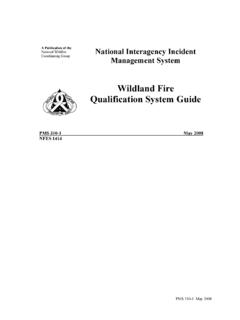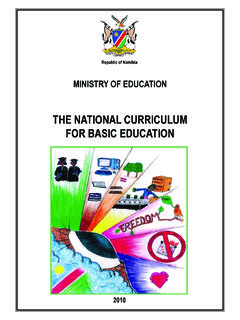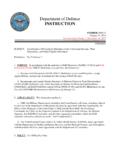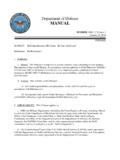Transcription of BY ORDER OF THE SECRETARY AIR FORCE MANUAL …
1 BY ORDER OF THE SECRETARY OF THE AIR FORCE AIR FORCE MANUAL 10-2503 6 JULY 2011 Incorporating Change 1, 31 MAY 2012 Operations OPERATIONS IN A CHEMICAL, BIOLOGICAL, RADIOLOGICAL, NUCLEAR, AND HIGH-YIELD EXPLOSIVE (CBRNE) ENVIRONMENT COMPLIANCE WITH THIS PUBLICATION IS MANDATORY ACCESSIBILITY: Publications and forms are available for downloading or ordering on the e-Publishing website at RELEASABILITY: There are no releasability restrictions on this publication OPR: AFCESA/CEXR Supersedes: AFH 10-2502, 30 October 2001, AFMAN 10-2602, 29 May 2003; AFMAN 32-4005, 30 October 2001 Certified by: AF/A7CX (Col Jeffery A. Vinger) Pages: 310 This MANUAL expands upon the guidance in Air FORCE Instruction (AFI) 10-2501, Air FORCE Emergency Management (EM) Program Planning and Operations. It also aligns the Air FORCE (AF) with Homeland Security Presidential Directive 5 (HSPD-5), the National Incident Management System (NIMS) and the National Response Framework (NRF).
2 This MANUAL integrates operational approaches to conventional and irregular warfare passive defense and consequence management operations using Chemical, Biological, Radiological, Nuclear, and High Yield Explosive (CBRNE) materials. This MANUAL provides standards for planning, logistical requirements, emergency response actions, emergency response organizational guidelines, exercises and evaluations, personnel training, detection, identification, warning and notification actions. It establishes responsibilities, procedures and standards for prevention, preparedness, response, recovery and mitigation resulting from conventional or irregular attacks using CBRNE materials. Within the context of this document prevention action which are not referenced in the document are taken throughout preparedness phase of incident management to protect lives and property through the use of intelligence, inspections, vulnerability assessments and improved security methods in ORDER to prevent or lessen the effects of attacks.
3 This MANUAL includes CBRNE procedures for use both within the continental United States (CONUS) and Outside the Continental United States (OCONUS). Its prescribed planning process helps responders to achieve unity of effort, allocate and use resources effectively and identify shortfalls 2 AFMAN10-2503 6 JULY 2011 in their response capabilities. This publication applies to Active Duty, Air FORCE Reserve, and Air National Guard (ANG) units worldwide. Consult cited policy directives, instructions, manuals and their supplements for specific policies, procedures and requirements. Send recommended changes and major command (MAJCOM) supplements to this publication to AFCESA/CEXR, 139 Barnes Drive, Tyndall AFB, FL 32403-5319 or email to Use AF Form 847, Recommendation for Change of Publication for recommended changes.
4 Ensure that all records created as a result of processes prescribed in this publication are maintained in accordance with Air FORCE MANUAL (AFMAN) 33-363, Management of Records, and disposed of in accordance with the Air FORCE Records Disposition Schedule (RDS) located at The use of the name or mark of any manufacturer, commercial product, commodity, or service in this publication does not imply endorsement by the Air FORCE . SUMMARY OF CHANGES These changes have not been integrated into the basic publication. The reader must use this IC in conjunction with the publication and these changes take precedence. This IC updates numerous administrative changes and Contamination Control Area (CCA) procedural changes in Attachment 9. Chapter 1 overview 6 overview .. 6 Purpose.. 6 Mission.. 7 Operational Environment.
5 7 Policy overview .. 9 Table Maturing and Emerging Challenges .. 11 Chapter 2 PREPAREDNESS 14 Preparedness overview .. 14 Figure Phases of Incident Management .. 14 Planning - Threat Probability and the Operational Environment.. 14 Figure Probability of Threats .. 15 Table Resources for Locating Information Regarding CBRNE Hazards .. 16 Table Representative Listing of Plans with CBRNE Defense Considerations .. 16 Figure Air FORCE Emergency Management Program Structural Relationships Installation Level .. 17 Table Potential CBRNE Defense-Related Disconnects Between Air FORCE Units And Other Services Or Nations .. 19 AFMAN10-2503 6 JULY 2011 3 Figure Vulnerability Assessment Process .. 20 Figure Increased Use and Impact of IEDs on American Casualty Figures in Iraq War (2003 2007) .. 21 Table Approximate High-Explosive Fragmentation Distances.
6 22 Table Representative CBRNE Vulnerabilities .. 24 Table Representative CBRNE Vulnerability Reduction Measures .. 25 Table Representative Examples of Commander s Intent regarding CBRNE Events .. 29 Figure Installation Command and Control (C2) Matrix .. 31 Table Representative Contamination Avoidance Activities across the CBRN Threat Spectrum .. 35 Table Considerations for Establishing CBRN Zones .. 36 Figure Installation Zone Identification Notional Example .. 38 Table CBRN Zone Transition Point Operational Guidelines .. 39 Table Contaminated Area Exit and Enter Actions .. 40 Table Contaminated Waste Control Planning Considerations .. 46 Table Equipment Considerations for CCTs .. 50 Training and Exercises.. 50 Chapter 3 RESPONSE 52 Response overview .. 52 CBRNE Operational Standards and Enabling Tasks.
7 52 Table CBRNE Defense Enabling Tasks .. 52 Table Wartime Chemical Attack Standards .. 53 Trigger Events.. 53 Table Effective Biological Event Mitigation Options: .. 53 Response Command and Control.. 54 Table CP Staff Responsibilities .. 54 Installation Notification and Warning System (INWS).. 56 Table Description of Defense Readiness Conditions .. 59 First and Emergency Responders Missions.. 60 Conventional CBRNE Attack Response.. 60 Figure Estimated VX Liquid Agent Deposition Time Following a SCUD Airburst Warhead Detonation 250 Meters (820 feet) Above Ground Level .. 63 Figure Potential TIC/TIM Delivery Mechanisms .. 77 Table Illustrative TIC/TIM Hazard Plume Dimensions .. 78 4 AFMAN10-2503 6 JULY 2011 Table Comparison of Immediately Dangerous to Life and Health (IDLH) Vapor Levels between CWAs and Representative High Threat TIC/TIM.
8 80 Table Ability of People to Sense Presence of TIC/TIM Vapor prior to Impairment .. 81 Terrorist Attack Response Actions.. 83 Withdrawal/Evacuation.. 85 Chapter 4 RECOVERY AND MITIGATION 87 overview of Recovery and Mitigation.. 87 Contamination Control.. 88 Table Essential Requirements for Conducting Decontamination Operations .. 90 Table Levels of Decontamination .. 92 Table Summary of Chemical Agent Transfer Tests involving VX .. 96 Table Summary of Biological Agent Contact Transfer Analysis .. 97 Table Half-Life of Chemical Agents .. 100 Table Aircraft Decontamination Techniques .. 102 Table Formulas for Creating Five Percent Chlorine Solution .. 103 Contamination Avoidance.. 107 Table Chemically Contaminated Object Handling Guidelines Background .. 109 Table Simplified Chemically Contaminated Object Guidelines.
9 110 Table Advanced Chemically Contaminated Object Rule Guidelines .. 110 Recovery Actions for Conventional and Irregular CBRNE Attacks.. 112 Figure Standard Nuclear, Biological, Chemical and Conventional Hazard Markers .. 115 Figure Expedient Nuclear, Biological, and Conventional Hazard Markers .. 116 Hazard Duration.. 118 Table Factors Affecting Determination of Hazard Duration Timeline .. 118 Table Half-Life Information for Selected Radioisotopes .. 119 Mission Continuation.. 120 Medical Protection and Casualty Management.. 120 Restoration of Infrastructure.. 122 Mitigation.. 122 Chapter 5 INFORMATION COLLECTION, RECORDS, AND FORMS 123 Information Collections.. 123 Records.. 123 Attachment 1 GLOSSARY OF REFERENCES AND SUPPORTING INFORMATION 124 AFMAN10-2503 6 JULY 2011 5 Attachment 2 IPE AND PPE ANALYSIS 165 Attachment 3 INCIDENT COMMANDER S GUIDE TO FIRST AND EMERGENCY RESPONSE MISSIONS 179 Attachment 4 SHELTER PROCEDURES 215 Attachment 5 CHEMICAL, BIOLOGICAL, RADIOLOGICAL, NUCLEAR, AND HIGH YIELD EXPLOSIVES RESPONSE DECISION TOOLS 232 Attachment 6 REPRESENTATIVE CBRNE THREAT PROFILES 258 Attachment 7 POST ATTACK RECONNAISSANCE (PAR) TEAMS 285 Attachment 8 CHEMICAL, BIOLOGICAL, RADIOLOGICAL AND NUCLEAR (CBRN) FORCE PROTECTION (FP) MEASURES 289 Attachment 9 CONTAMINATION CONTROL AREA (CCA) PROCEDURES 294 6 AFMAN10-2503 6 JULY 2011 Chapter 1 overview overview .
10 How Air FORCE installations and units operate in a chemical, biological, radiological, nuclear, and high yield explosive environment is an evolving effort. In 2002 the Air FORCE implemented the counter-chemical warfare concept of operations (CONOPS) that changed how installations prepared for and responded to conventional chemical munitions attacks. The AF further defined the most probable threat as tactical ballistic missiles. That reevaluation of the threat became the basis for developing tactics, techniques and procedures (TTP) for installations to recover and continue mission operations. In 2003, the AF began investigating potential vulnerabilities for biological attacks by conducting exercises at Kunsan AB, Korea. These exercises led to the development and refinement of TTPs for responding to conventional and irregular biological warfare attacks.
















